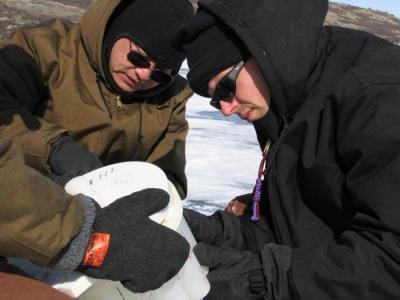Scientists have examined 5,600 years of climate history from two lakes in Kangerlussuaq, near the Norse "Western Settlement." Unlike ice cores taken from the Greenland ice sheet hundreds of miles inland, the new lake core measurements reflect air temperatures where Vikings lived in the 14th and 15 centuries, as well as those experienced by the Saqqaq and the Dorset, Stone Age cultures that preceded them. What climate scientists have been able to ascertain is that an extended cold snap, called the Little Ice Age, gripped Greenland beginning in the 1400s, and that has been cited as a major cause of the Norse's disappearance. New research shows the climate turned colder in an earlier span of several decades, setting in motion the end of the Greenland Norse.
The Vikings arrived in Greenland in the 980s, establishing a string of small communities along Greenland's west coast. Another grouping of communities, called the "Eastern Settlement" also was located on the west coast but farther south on the island. The arrival coincided with a time of comparatively mild weather, similar to that in Greenland today, but beginning around 1100, the climate began an 80-year period in which temperatures dropped 4 degrees Celsius/7 degrees Fahrenheit, scientists concluded from the lake readings.
While that may not be considered precipitous, especially in the summer, the change could have ushered in a number of hazards, including shorter crop-growing seasons, less available food for livestock and more sea ice that may have blocked trade.
Archaeological and written records show the Western Settlement persisted until sometime around the mid-1300s. The Eastern Settlement is believed to have vanished in the first two decades of the 1400s.
The researchers also examined how climate affected the Saqqaq and Dorset peoples. The Saqqaq arrived in Greenland around 2500 B.C. While there were warm and cold swings in temperature for centuries after their arrival, the climate took a turn for the bitter beginning roughly 850 B.C., the scientists found. "There is a major climate shift at this time," says William D'Andrea, a postdoctoral researcher at the University of Massachusetts–Amherst. "It seems that it's not as much the speed of the cooling as the amplitude of the cooling. It gets much colder."

William D'Andrea, right, and Yongsong Huang took cores from two lakes in Greenland to reconstruct 5,600 years of climate history near the Norse Western Settlement. Credit: William D'Andrea&Brown University
The Saqqaq exit coincides with the arrival of the Dorset people, who were more accustomed to hunting from the sea ice that would have accumulated with the colder climate at the time. Yet by around 50 B.C., the Dorset culture was waning in western Greenland, despite its affinity for cold weather. "It is possible that it got so cold they left, but there has to be more to it than that," D'Andrea said.
"The record shows how quickly temperature changed in the region and by how much," said co-author Yongsong Huang, professor of geological sciences at Brown, principal investigator of the PNAS study. "It is interesting to consider how rapid climate change may have impacted past societies, particularly in light of the rapid changes taking place today."
Climate may not have been the biggest factor in the demise of the Norse Western Settlement. The Vikings' sedentary lifestyle, reliance on agriculture and livestock for food, dependence on trade with Scandinavia and combative relations with the neighboring Inuit are also believed to be contributing factors.




Comments